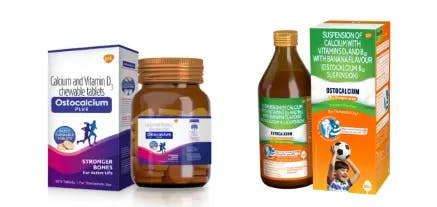There are many things an individual can do to improve their bone health right from childhood to old age1. These include exercise, good lifestyle habits and eating a diet rich in vitamins and minerals2. Of these, 2 nutrients in particular are important for building strong bones and they are Calcium and Vitamin D3. No wonder Calcium and Vitamin D3 is recommended as the first line of therapy in the prevention and treatment of osteoporosis and osteoporosis-related fractures4. This article will explore how Calcium and Vitamin D3 helps with bone health.
Some interesting facts about Calcium:
Here are some interesting bone facts you need to know:
Fact 1: Calcium helps build bones. 99% of the body’s Calcium is present in the bones5
Calcium is essential for strong bones. Calcium from food is absorbed in our small intestine and deposited in the bones5. Eating Calcium-rich foods = more Calcium for absorption and utilization = strong bones.
Fact 2: Calcium is required for important life activities involving hormones, nerves, muscles and heart3,5
Apart from building strong bones, Calcium has other roles in the body too. Calcium is required for the heart to function well, muscles control, and for nerve conduction. Calcium is also required for our blood to clot normally3,5. These are very important and critical functions in our body6. Hence, eating Calcium-rich food is important.
Fact 3: When you eat foods low in Calcium, Calcium from the bones are leeched to make up for the deficit 6,7
Our bones are a reservoir of Calcium in the body6. When our dietary intake of Calcium is low, the deficit is made up by leeching it from the bones. Overtime, this makes our bones fragile and weak and might lead to osteoporosis (where the bones can easily break)7.
Did you know? Calcium is not made in the body. It must be absorbed through the food we eat
Some interesting facts about vitamin D3:
Here are some interesting bone facts you need to know:
Fact 1: Calcium alone is of little use. Vitamin D3 helps in the absorption of Calcium
Weight loss and weight fluctuations throughout life seems to have an impact on the bone too. Among pre-menopausal women; quick and drastic weight loss within 3-4 months might cause bone loss. Instead, a moderate weight loss over 6 months shows little to no bone loss in premenopausal women3.
Fact 2: Lack of Vitamin D3 can also weaken bones
Predominant vegetarian diets, low milk consumption and lack of sun exposure can lead to low Calcium and Vitamin D3 levels3. Prolonged low intake of both these bone nutrients might make you prone to bone loss.
Fact 3: Children with poor Vitamin D3 diets have weak bones, which results in a change in bone shape and deformities
Childhood and adolescence are crucial phases for building strong bones. What happens if there is low vitamin D intake during these phases? The bones become weak and break easily; they bend or develop other deformities.8
Osteoporosis is a slowly developing bone disease that seriously affects the quality of life in middle-aged and elderly individuals2. A lifetime low intake of Calcium and Vitamin D3 can make you prone to having fragile bones. Considering the important role of Calcium and Vitamin D3 in bone health, it is important to get these nutrients from the diet or consume supplements of Calcium and Vitamin D3 2,4. But remember, having a balanced diet replete in these nutrients for bone health is only one part of osteoporosis prevention. Good lifestyle habits and adequate physical activity additionally can ensure bone health is maintained.
References
1. Office of the surgeon general (US). Bone health and osteoporosis: A report of the surgeon general. Rockville (MD): office of the surgeon general (US); 2004. 7, lifestyle approaches to promote bone health. Available from: https:/www.Ncbi.Nlm.Nih.Gov/books/NBK45523/
2. National institute of arthritis and musculoskeletal and skin diseases. Bone Health for Life: Health Information Basics for You and Your Family. Available from: https:/www.bones.nih.gov/health-info/bone/bone-health/bone-health-life-health-information-basics-you-andyour-family. Accessed on: 20 august 2020.
3. National institute of arthritis and musculoskeletal and skin diseases. Calcium and Vitamin D3: Important at Every Age. Available from: https:/www.bones.nih.gov/health-info/bone/bone-health/nutrition/calcium-and-vitamin-d-important-every-age. Accessed on: 20 august 2020.
4. Gielen E, Boonen S, Vanderschueren D, et al. Calcium and VitaminD3 supplementation in men. J osteoporos. 2011;2011:875249. Doi: 10.4061/2011/875249
5. Li K, Wang XF, Li DY, et al. The Good, The Bad, And The Ugly Of Calcium Supplementation: A Review Of Calcium Intake On Human Health. Clin Interv Aging. 2018;13:2443–2452.
6. Institute of Medicine (US) Committee to Review Dietary Reference Intakes for Vitamin D3 and Calcium; Ross AC, Taylor CL, Yaktine AL, et al., editors. Dietary Reference Intakes for Calcium and Vitamin D3 . Washington (DC): National Academies Press (US); 2011. 2, Overview of Calcium. Available from: https:/www.ncbi.nlm.nih.gov/books/NBK56060/
7. American Academy of Orthopedic Surgeons. Calcium, Nutrition, and Bone Health. Available from: https:/orthoinfo.aaos.org/en/stayinghealthy/calcium-nutrition-and-bone-health/. Accessed on: 21 July 2020
8. Office of the Surgeon General (US). Bone Health and Osteoporosis: A Report of the Surgeon General. Rockville (MD): Office of the Surgeon General (US); 2004. 2, The Basics of Bone in Health and Disease. Available from: https:/www.ncbi.nlm.nih.gov/books/NBK45504/ . Accessed on: 21 July 2020.
9. National institute of arthritis and musculoskeletal and skin diseases. Osteoporosis Overview. Available from: https:/www.bones.nih.gov/ health-info/bone/osteoporosis/overview. Accessed on: 21 July 2020




